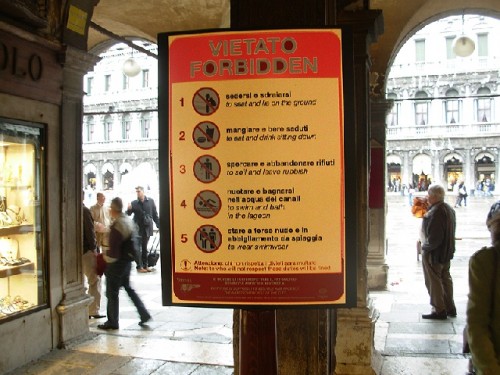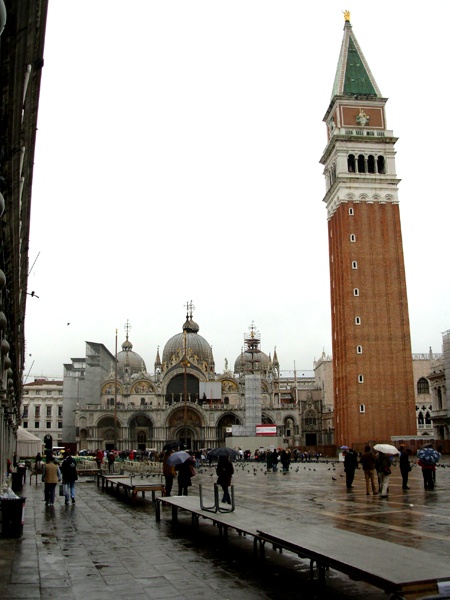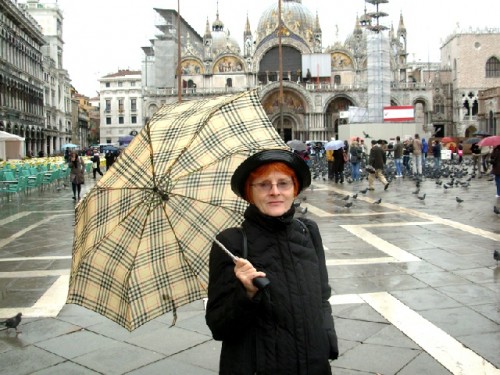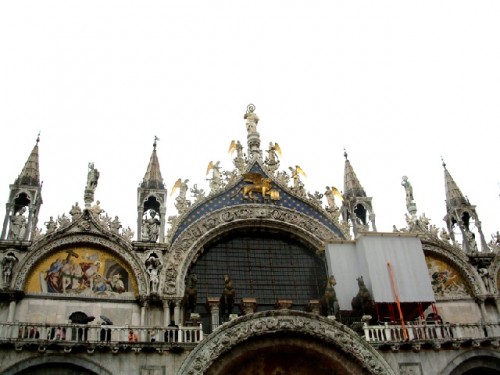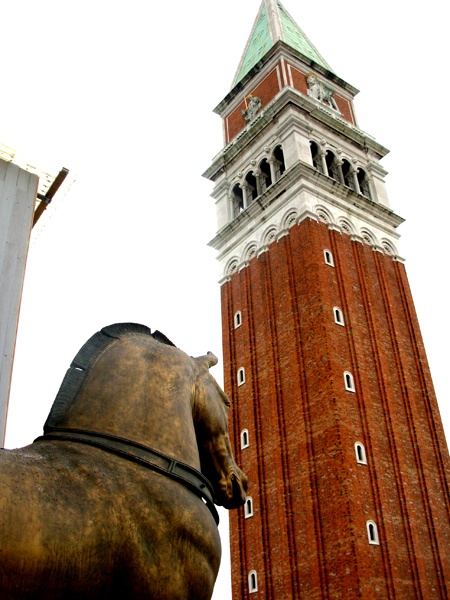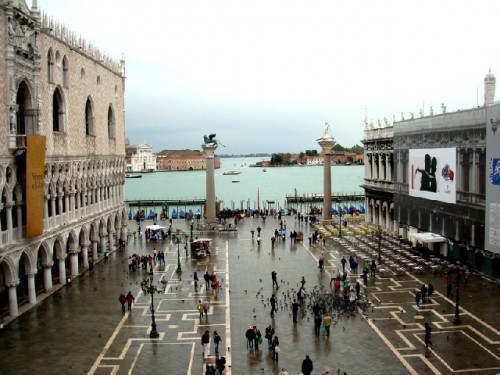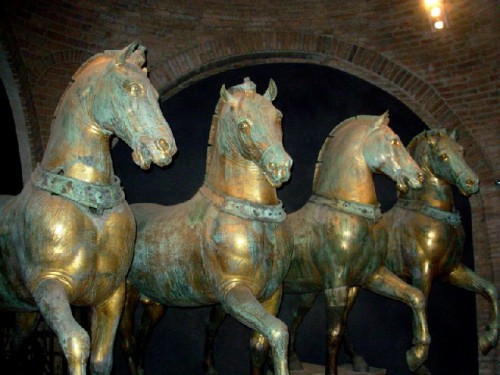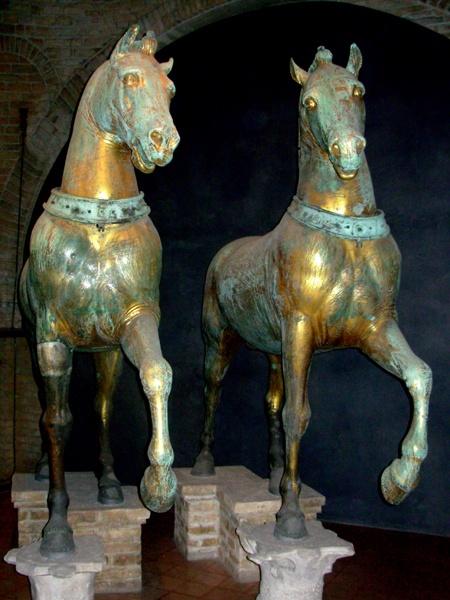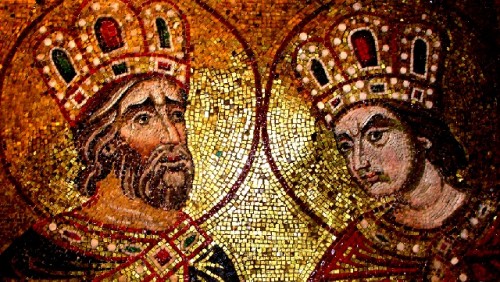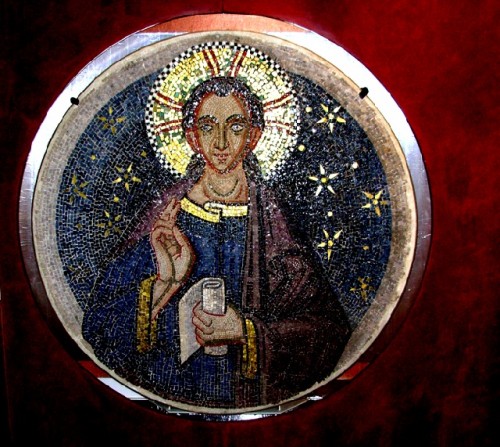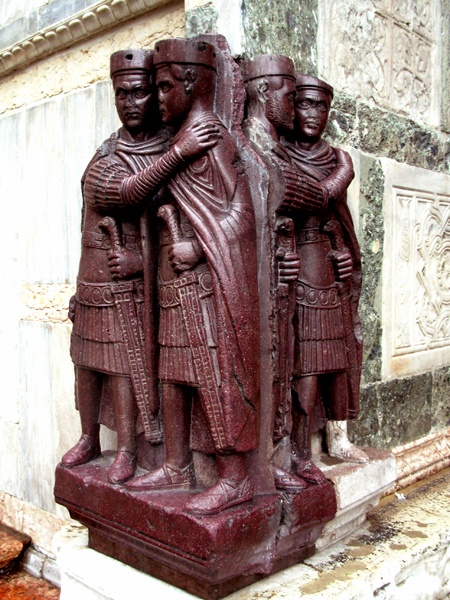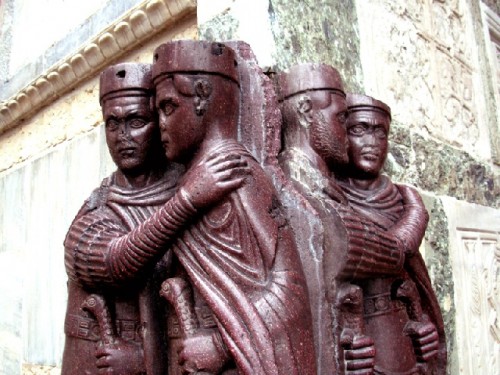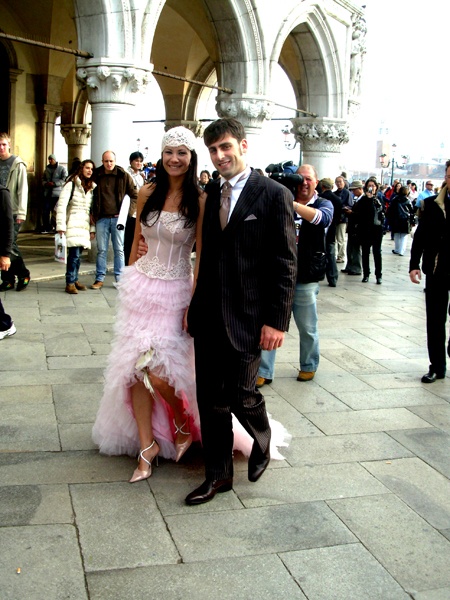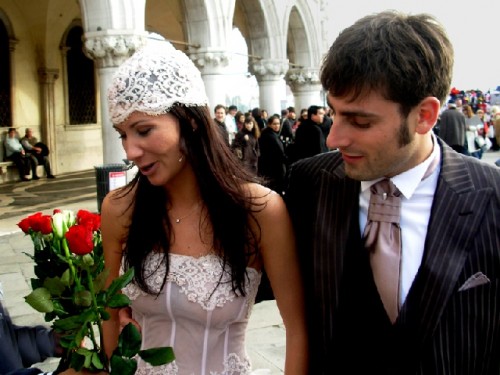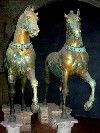Venice: Piazza San Marco
Pigeons and Dungeons
By: Charles Giuliano - Dec 22, 2007
Crossing the Grand Canal over the Accademia Bridge we found our way through a maze of piazzas and alleys to the entrance to the Piazza San Marco. Just before we came into the vast open area there was a curious sign that informed what was forbidden. It was serious but somewhat comic with warnings like, don't wear swim suits, the thought had not occurred to us as it was a rainy day in late October, and don't swim in the lagoons. Good heavens.
Having been duly warned we turned a corner and found ourselves in the most popular tourist attraction of all of Europe. Venice is such a luring destination that there is even a simulacrum of it, lagoons, gondolas and all, contained within the Vegas hotel The Venetian. And an even older replication/ theft/ restoration in the courtyard of the Gardner Museum in Boston. The aristocratic British making the grand tour hauled home the vedute paintings of Canaletto (1697-1768), the 18th century version of post cards, to grace the walls of their mansions.
But on this blustery afternoon with a chilly rain there were few if any tourists in view. Just the usual flocks of hungry pigeons desperate for the corn peddled to tourists to get those all important photo documents. While rather gloomy the weather proved to be a mixed blessing by allowing one to enter the Basilica with a relatively short delay. Although it was getting late, and near to supper time, we explored the church which was consecrated on October 8, 1094 and completed in 1617. The design has strongly Eastern and Byzantine features particularly in its array of domes and what is left of the original mosaics.
Later in the week, on a Saturday, we returned to Piazza San Marco with Astrid's relatives Horst and Bettina Hiemer from Berlin. It was a better day, one of the best, of a generally rainy and overcast week in Venice. But the down side was that the Piazza was thronged with visitors and the line to the Basilica was way too long to wait. Instead, we opted for the Doge's Palace and its endless maze of enormous chambers with the paintings of Tintoretto (1518-1594) which are among the largest such efforts in the world. Earlier in the week we had visited Scuola San Rocco which is filled with remarkable works by Tintoretto who may only be truly understood and appreciated in Venice.
Like most Italian cathedrals the Basilica of San Marco is rather dark inside. The use of stained glass and dramatic light is primarily French and Gothic. It is the lack of this sense of light which is the greatest disappointment of Italian churches and cathedrals. The exception to this, of course, is the work of the Baroque master Bernini who knew how to make light an element of his sculpture and architecture.
On this relatively quiet afternoon we were able to explore the Basilica including climbing up to the balcony over the portico that overlooks the Piazza and to visit the museum housed on this level. It is in the museum that we found the originals of the famous Four Horses. By some accounts they originally were a part of the Arch of the Emperor Trajan, who ruled from 98 to 117 A.D., and had long been seen in the Hippodrome of Constantinople. During the Fourth Crusade, when the Doge Enrico Dandolo orchestrated the sack of Constantinople, they were stolen in 1204 and sent to Venice. Today, replicas of the originals are seen on the balcony. Also, at that time, the Venetians looted "The Four Tetrachs" (circa 305 A.D.) one of the great examples of Late Roman portraiture. The complex group made of the Imperial porphyry, one of the hardest and most beautiful stones that a sculptor may carve, is embedded in a corner of the exterior of the Basilica. The Tetrachs were the four, co-rulers of the then vast but crumbling Roman Empire.
From the balcony of San Marco we looked down at the rain spattered and virtually empty Piazza. Moving to the left we came to a vantage point to look along the Piazzetta out to the lagoon with the Doge's Palace on the left and the Biblioteca Marciana, designed by Jacopo Sansovino (1486-1570) on the right. At the edge of the canal are two columns, dedicated to the patrons of Venice, Marco and Todara with sculptures of the Lion of San Marco (the logo of Venice) and a sculpture of Saint Teodoro of Amasea who is standing on the sacred crocodile of Egypt. In the distance is seen the Punta della Salute to the left of Baldassare Longhena's Santa Maria della Salute. Construction of the church began in 1631 when the architect was just twenty six.
We studied the magnificent Four Horses which are less than dramatically installed in the dimly lit museum. Much of the original patina is preserved and they are truly among the very best examples of Roman bronze sculpture that have survived. Originally, they would have led a chariot with an occupant. No such work exists today but there is the spectacular life-size Equestrian Statue of Marcus Aurelius (161-80 A.D.) a replica of which is displayed in the Piazza del Campidoglio in Rome which was designed by Michelangelo. The original, because of the ravages of pollution, has been installed in the museum that flanks the Piazza. From the time of the Marcus Aurelius sculpture there was not another such effort until Donatello's equestrian bronze sculpture of Erasmo di Narni, known as Gattamelata, cast some time between 1443-53, which is on view in Padua. Exploring the museum of San Marco we also encountered examples of the original mosaics. Much of what is seen in San Marco today is the result of 19th century restorations.
Returning on the weekend was a quite different experience but it was great to share it with Horst and Bettina. It took much of the afternoon to explore the vast Doge's Palace and its enormous now empty rooms. One got a sense of the style of governance in the rich and powerful Republic of Venice. One thought of the setting for Shakespeare's plays "Othello" and the "Merchant of Venice" or, the Giuseppe Verdi opera "Otello." Following along we crossed the Bridge of Sighs which led down into an endless and horrific tour of the dungeon and torture rooms. The tales they evoked of men left to die under the most miserable conditions saddened and angered me. It is a part of the dark legacy of tyranny, intolerance and repression. One was vividly reminded that we have not outlived such treatment of enemies, prisoners of war, and "terrorists." It made one aware that, for all of its magnificence, Venice ruthlessly achieved its wealth and power through any means necessary.
So one emerged back into the light of day with those dark and disturbing thoughts. But we were immediately caught up in a joyous occasion. There were a bride and groom making their way through the Piazetta. She was lovely and radiant as the groom clung to her with the fresh glow of a marriage ceremony. A photographer was recording the moment as she was presented a bouquet of roses by a vendor. We were able to share in their celebration and our wonderful reunion in the Piazza San Marco.

